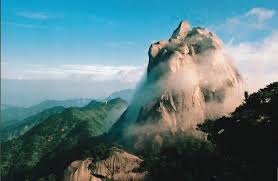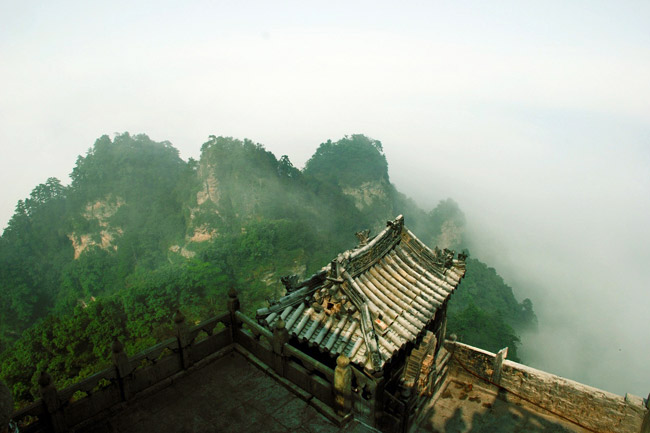Nestled between the peaks and precipices of Wudang is a cluster of ancient Taoist temples. At the top of a windy staircase made of large gray stones, we enter the gates of one of them. There, in a large courtyard we find a group of young men, seekers of the Tao, practicing martial arts. Wielding fans emblazoned with the yin-yang symbol, they carefully pace in circular patterns, their motions as smooth as flowing water.
The quiet scene is suddenly interrupted as they break into combat and perform gravity-defying leaps and flips. At the end of their training session, the Taoists return to their places, completing the balance of strength and grace, vitality and stillness.

The Wudang Mountains (武當山) are a physical representation of the Taoist philosophy of harmonizing opposite forces. Rising high above the bustling markets and far from the mundane world into the misty clouds, it is at once majestic and serene.
At its highest point, the aptly named “Heavenly Pillar Summit” (天柱峰) reaches 1,613 meters into the sky, and is surrounded by an undulating panorama of 72 peaks, 36 cliffs, and 24 streams. Add soaring pines and countless shades of lush green stretching into the horizon, and you've got a living canvas of a timeworn Chinese landscape painting.
Slopes are decorated with an ancient complex of Taoist temples and monasteries impossibly situated off the sides of towering bluffs. These architectural marvels were erected over the course of five dynasties—the Tang, Song, Yuan, Ming, and Qing—spanning over a millennium of Chinese history.
Much of what remains there today is the result of a massive construction project undertaken by the Yongle Emperor of the Ming Dynasty during the early fifteenth century. And today, Wudang Mountain is renowned as the cradle of Taoism.
Wudang and Wushu

Wudang holds the honorific title of “The First Divine Mountain Under Heaven” (天下第一仙山). For centuries, this sacred mountain was the choice destination for Taoist cultivators, making it the primary hub for those in search of the Tao, or the Way.
In addition to being a place for spiritual elevation, Wudang is also home to Taoist martial arts—Wudang quan, which place emphasis on the mind and spirit as the source of strength.
The most famous cultivator from Mt. Wudang was the Taoist hermit Zhang Sanfeng. The History of Ming describes him as seven feet tall, with the posture of a pine tree, and whiskers shaped like spears. He was said to have lived as a human over 200 years and achieved immortality as a deity. He was the founder of the martial art style Taichi chuan, or tai chi, which has remained popular (though largely modified) to this day.
This year’s fan dance “The Warriors of Wudang Mountain” exemplifies the gentle strength of the Wudang warriors and brings the tai chi symbol to life on stage.
Wudang Through Dance
Don’t be confused, though, what we are performing is classical Chinese dance, not martial arts. The two traditional art forms have a shared history, hinted at by the fact that the Chinese characters for dance and martial arts are both pronounced wǔ. And early forms of classical Chinese dance, especially the various tumbling techniques, were passed down in part via martial arts.
But, as fellow dancer Ming Liu (no relation) put it in his blog, you can think of them as twins born 5,000 years ago who have very different personalities.
If you’re interested in more about the history of classical Chinese dance and about its relationship with martial arts, this article by Mr. Li Hongzhi is a must.
Have you watched this year’s dance, “The Warriors of Wudang Mountain?” See if you can spot the allusions to the yin-yang symbol in our movements and formations. And please write me in the comments section below to tell me what you think!

Gary Liu
Dancer
April 15, 2014


